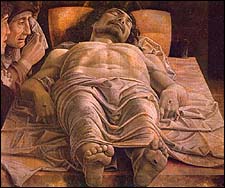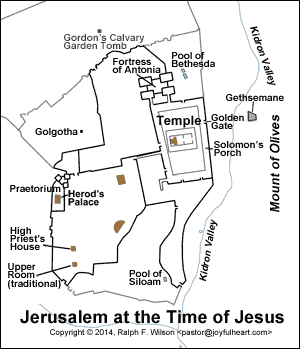
|
Old Testament
New Testament
Gospels
Acts
Paul's Letters
General Letters
Revelation
Topical Studies
Beginning the Journey (for new Christians). en Español

|
Old Testament
New Testament
Gospels
Acts
Paul's Letters
General Letters
Revelation
Topical Studies

|
Home
Bible Studies
Articles
Books
Podcasts
Search
Menu
Donate
About Us
Contact Us
FAQ
Sitemap
107. Burial in Joseph's Tomb (Luke 23:50-56)
 Andea Mantegna, 'The Lamentation over the Dead Christ' (c. 1490), tempera on canvas, 68 x 81 cm, Pinacoteca di Brera, Milan. Larger image. |
"50 Now there was a man named Joseph, a member of the Council, a good and upright man, 51 who had not consented to their decision and action. He came from the Judean town of Arimathea and he was waiting for the kingdom of God. 52 Going to Pilate, he asked for Jesus' body. 53 Then he took it down, wrapped it in linen cloth and placed it in a tomb cut in the rock, one in which no one had yet been laid. 54 It was Preparation Day, and the Sabbath was about to begin. 55 The women who had come with Jesus from Galilee followed Joseph and saw the tomb and how his body was laid in it. 56 Then they went home and prepared spices and perfumes. But they rested on the Sabbath in obedience to the commandment." (Luke 23:50-56, NIV)
It is over. Jesus has breathed his last. Now his friends and disciples work quickly to see to an honorable burial before nightfall and the Sabbath that begins Friday night at sundown.
Why do the Gospel writers take time discussing Jesus' burial? First, it is remarkable that Jesus, a condemned criminal, receives a proper burial at all. In the Roman world, condemned prisoners were typically denied burial. In a Jewish context, condemned men were probably buried ignominiously in a common grave (see Deuteronomy 21:22-23).1186
But more importantly, the Gospel writers are laying the groundwork to describe the amazing circumstances of the resurrection that is to take place Sunday morning. That is why the details of the burial of Jesus are so important.
Joseph of Arimathea (Luke 23:50-51)
Joseph of Arimathea is a highly-placed friend who cares deeply about Jesus' burial. We don't know if he has ever talked to Jesus one-on-one. John calls him a secret disciple (John 19:38). But Joseph chooses this moment to make his allegiance clear.
"Now there was a man named Joseph, a member of the Council, a good and upright man, who had not consented to their decision and action. He came from the Judean town of Arimathea and he was waiting for the kingdom of God." (Luke 23:50-51)
The phrase "member of the Council" (NIV) or "counsellor" (KJV) is the Greek noun bouleutēs, "a member of an advisory or legislative body, councilor," here referring to the Sanhedrin.1187 It is derived from the noun boulē, rendered in verse 51 as "decision" (NIV) or "counsel" (KJV).
He not only holds an exalted position in society, Luke describes him as good (agathos) and righteous (dikaios), person, a man of integrity. He makes it clear that Joseph hasn't gone along with the Sanhedrin's condemnation of Jesus, that he has not consented to their decision (Greek boulē). "Consented" is the Greek verb synkatatithēmi, "agree with, consent to" something," literally, "put down the same vote as."1188
Joseph is from the town of Arimathea, mentioned only here and in other parallels from the Gospels. It is identified with Ramathaim-zophim (1 Samuel 1:1), modern Rentis, just north of Jerusalem.1189
Joseph is a seeker, "waiting for the kingdom of God." "Waiting" is the Greek verb prosdechomai, "to look forward to, wait for."1190 The word is used early in Luke's Gospel to describe godly people who don't yet participate in the Kingdom, but are eagerly awaiting it -- Simeon (Luke 2:25), Anna (Luke 2:38), etc.
Joseph Asks for Jesus' Body (Luke 23:52)
Joseph is wealthy (Matthew 27:57) and a "prominent member" of the Sanhedrin (Mark 15:43). Now he uses his personal resources and position to assist the Lord whom he loves.
"Going to Pilate, he asked for Jesus' body." (Luke 23:52)
I sometimes see human relations in terms of "points." This is not a Christian viewpoint based on love and the dignity of each person under God, but it is often how societies work. You accrue points by the way you conduct yourself, your integrity, etc., as well as by the favors you do for people. "You owe me for that," you may say when you do someone a big favor. But there comes a time to cash in your points and call in some favors in order to get what you need. When you do that, you diminish your ability to get future consideration. But there is a time to risk all. For Joseph, this was such a time.
He goes immediately to Pilate and asks for Jesus' body. He does it on behalf of Jesus, not to further his own career. Mark notes that "he went boldly" (Mark 15:43), using the Greek verb tolmaō, "to show boldness or resolution in the face of danger, opposition, or a problem, dare, bring oneself to (do something)."1191
Often, secret believers burrow deeper in a time of crisis, but sometimes they rise to the occasion to do what is required. John's Gospel notes that Joseph was assisted by Nicodemus (John 19:39-40), a fellow member of the Sanhedrin who had previously come to Jesus by night (John 3:1-8). He, too, is ready to declare his allegiance to Jesus.
Claiming the Body (Luke 23:53a)
Joseph receives permission after Pilate determines that Jesus is actually dead, certified by the centurion in charge of the crucifixion detail (Mark 15:43-45). Then he goes personally to take care of the body.
"Then he took it down, wrapped it in linen cloth...." (Luke 23:53a)
Let's examine each step briefly. First, he takes down the body. The Greek verb is kathaireō, "to bring down from one level to another, take down, bring down, lower."1192 Either the upright member of the cross is lowered to the ground, or the cross member unfastened from the upright and the attached body lowered to the ground. The spikes are pulled out, the body is gently lifted onto a clean linen cloth (Greek sindōn, Matthew 27:59), wrapped or folded in it (Greek entylissō[1193]), and carried to the nearby tomb.
Placing the Body in a New Tomb (Luke 23:53b)
 Locations of traditional tomb (Church of the Holy Sepulcher) and Gordon's Calvary. (larger map) |
"... and placed it in a tomb cut in the rock, one in which no one had yet been laid." (Luke 23:53)
The tomb has been carefully prepared. It is not a natural cave, but one which has been "hewn in rock" (Greek laxeutos).1194 It is found in a garden: "At the place where Jesus was crucified, there was a garden, and in the garden a new tomb, in which no one had ever been laid" (John 19:41).
Green describes the type of tomb alluded to in this passage:
"... Fashioned by quarrying into the side of a rock face. Such a tomb might have included a forecourt before a cave, the mouth of which could be covered by a large, disk-shaped stone set in a groove cut in the rock beneath. The entrance would lead into the burial chamber with a stone step and central pit of sufficient height to allow persons to stand in order to prepare a corpse for internment on one of the stone benches carved into the rock along the sides of the chamber.... The body was placed on a sand-covered stone bench; after a twelve-month period of decomposition, the bones were collected and placed in an ossuary."1195
Tombs of this type might contain 8 niches (3 on each side, two on the end), or 13 niches (4 on each side, 3 at the end, and one on each side of the entrance).1196 Two Greek nouns are used to describe the "tomb" (NIV) or "sepulchre" (KJV): mnēma (verse 53) and mnēmeion (verse 55). They have a similar meaning -- "grave, tomb," though mnēmeion can also carry the idea of "monument."1197
What is the significance of Jesus being buried in a brand new tomb? Probably to reflect the great esteem in which Joseph holds Jesus. It also counteracts any suggestion that when Jesus' body is missing on resurrection morning that the women mistake it for another burial.
But it also seems to fulfill Isaiah's prophecy of the Suffering Servant:
"And they made his grave with the wicked
and with a rich man in his death,
although he had done no violence,
and there was no deceit in his mouth." (Isaiah
53:9)
After preparing the body, Joseph and Nicodemus gently place Jesus' body on one of the stone ledges in the tomb, roll a large stone in front of the door (Matthew 27:60b), and depart.
Sabbath Is About to Begin (Luke 23:54)
Luke notes carefully the time of the burial:
"It was Preparation Day, and the Sabbath was about to begin." (Luke 23:54)
The Greek noun paraskeuē, "preparation" refers to the day of the week prior to Sabbath. Here Friday must be meant.1198 The phrase "about to begin" (NIV), "drew on" (KJV) is the Greek verb epiphōskō. The word means "to grow towards or become daylight, shine forth, dawn, break," perhaps, "draw on." Here it refers not to the coming of the sunrise, but the sunset. This usage may refer to the lighting of lamps, but most likely the appearance of the evening star.1199
The Women Witness Jesus' Burial (Luke 23:55-56)
"The women who had come with Jesus from Galilee followed Joseph and saw the tomb and how his body was laid in it. Then they went home and prepared spices and perfumes. But they rested on the Sabbath in obedience to the commandment." (Luke 23:55-56)
Earlier, Luke has explained that Jesus' company of disciples traveling with him included women.
"The Twelve were with him, and also some women who had been cured of evil spirits and diseases: Mary (called Magdalene) from whom seven demons had come out; Joanna the wife of Cuza, the manager of Herod's household; Susanna; and many others. These women were helping to support them out of their own means." (8:1-3)
Now these women play another role in Jesus' life. In caring for the final needs of his burial, they stumble upon one of the central truths of Jesus' life and ministry. Several women have followed Joseph and Nicodemus to the garden tomb. Mark identifies them as "Mary Magdalene and Mary the mother of Joses" (Mark 15:47). They know the exact place of Jesus' burial. On resurrection morning there is no mistaken location.
Now they return to the place where they are staying, planning to come back with spices and perfumes after the Sabbath to complete the preparation of Jesus' body. The Greek noun aroma refers to "any kind of fragrant substance, fragrant spice, salve, oil, perfume."1200 "Perfumes" (NIV) and "ointments" (KJV) render the Greek noun myron, "ointment, perfume."1201
Though the Synoptic Gospels don't mention it, John indicates that Joseph and Nicodemus had brought with them about 75 pounds of myrrh and aloes. These were inserted in the wrappings as they wrapped each limb with strips of linen (John 19:39-40). Marshall observes, "It is improbable in eastern conditions that women would have come afterwards to perform rites on a body that had not already had some kind of anointing to preserve it."1202 The women bring spices to complete the body's preparation on Sunday morning.
Lessons for Disciples
I see several lessons for disciples.
First, that there is a time for us to publicly identify ourselves with Jesus, even though fear might have prevented it in the past. Both Joseph of Arimathea and Nicodemus put their lives and reputations on the line as they assist Jesus.
Second, everything we have is to be put at Jesus' disposal. Joseph is wealthy and has a brand new tomb. He is honored for Jesus to be placed there. Nicodemus no doubt paid for expensive burial ointments out of his own finances. So did the women. Even in death, his disciples bestow on him an extravagant love. Our possessions are to be used for our Lord's glory.
Third, Jesus' death and burial are carefully documented. Jesus is actually dead. Jesus' disciples are sure of it. They have seen the soldiers finally pierce his side so that water and blood run out (John 19:33-34). They have handled his lifeless corpse. They have anointed it and wrapped it carefully and laid him in a tomb blocked by a heavy stone. The Gospel writers give us this detail so that we can know with certainty that Jesus' resurrection is no error, no mistaken identity, no fluke. The resurrection is one of the central Christian beliefs and it is solid.
Now we rest as do the women during the Sabbath day. For early Sunday morning we will encounter an event that will occupy us fully into the evening. He is risen! He is risen indeed!
Prayer
Father, I thank you that Jesus had friends who, at great personal cost, showed him love, respect, and honor even following the shame of his death. I want to be counted as one of those followers who will not desert you, even when I am hurt, disillusioned, or bewildered. Thank you for the historical reality of the resurrection. In Jesus' name, I pray. Amen.
Key Verse
"Then he took it down, wrapped it in linen cloth and placed it in a tomb cut in the rock, one in which no one had yet been laid." (Luke 23:53)
Questions
Click on the link below to discuss on the forum one or more of the questions
that follow -- your choice.
https://www.joyfulheart.com/forums/topic/2022-107-burial/
- What do we learn about Joseph of Arimathea? What kind of character does he possess?
- Why has Joseph been a secret disciple, do you think? Why does he come forward now when identifying with Jesus can only hurt his standing with his peers?
- What do the Gospels tell us about the tomb and Jesus' burial? Why are these details important?
- Why is the timing important? Why the mention of the Sabbath?
- What do we know about these women who followed Jesus? Why do they follow the body to the tomb?
- Why are Jesus' followers so extravagant at his death? What does that teach us?
 Lessons compiled in 805-page book in paperback, Kindle, & PDF. |
Endnotes
[1186] Green, Luke, p. 831, fn. 9, cites 1 Kings 13:21-22; Jeremiah 26:23; Josephus, Antiquities, 5.1.14 §§44; 4.8.6 §§202.
[1187] Bouleutēs, BDAG 183.
[1188] Synkatatithēmi, BDAG 953.
[1189] Marshall, Luke, p. 879.
[1190] Prosdechomai, BDAG 877, 2b.
[1191] Tolmaō, BDAG 1010, b.
[1192] Kathaireō, BDAG 487, 1.
[1193] Entylissō, "to wrap something around an object, wrap (up)" (BDAG 343, 1).
[1194] Marshall, Luke, p. 880, who indicates that it does not mean "built with hewn stones," as demonstrated by Deuteronomy 4:49 LXX.
[1195] Green, Luke, p. 830, fn. 7.
[1196] Edersheim, Life and Times 2:318.
[1197] Menmeion, BDAG 654, 2.
[1198] Marshall, Luke, p. 881.
[1199] Epiphōskō, BDAG 386. Among others, Marshall (Luke, p. 881) cites E. Lohse, TDNT 7:20, note 159.
[1200] Aroma, BDAG 140.
[1201] Myron, BDAG 662.
[1202] Marshall, Luke, p. 880. He cites Josephus, Antiquities 17:199; Wars 1:673, but acknowledges that these references don't attest a second anointing.
Copyright © 2026, Ralph F. Wilson. <pastor![]() joyfulheart.com> All rights reserved. A single copy of this article is free. Do not put this on a website. See legal, copyright, and reprint information.
joyfulheart.com> All rights reserved. A single copy of this article is free. Do not put this on a website. See legal, copyright, and reprint information.


 To be notified about future articles, stories, and Bible studies, why don't you subscribe to our free newsletter, The Joyful Heart, by placing your e-mail address in the box below. We respect your
To be notified about future articles, stories, and Bible studies, why don't you subscribe to our free newsletter, The Joyful Heart, by placing your e-mail address in the box below. We respect your